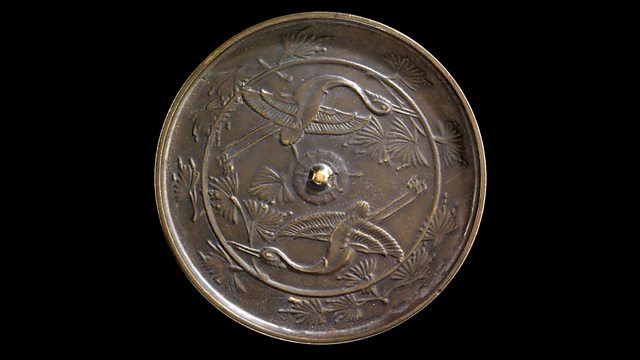Japanese bronze mirror
The history of the world as told through objects arrives in 12th Century Japan. Neil MacGregor tells the story of a bronze mirror found at the bottom of a sacred pond.
The history of humanity as told through one hundred objects from the British Museum in London. This week Neil MacGregor is looking at objects from Tanzania, Britain, Java and central Europe, exploring the great arcs of trade that connected Africa, Europe and Asia around a thousand years ago. Today he arrives in Japan with an object that offers a dramatic twist on the week's theme. This small mirror from the bottom of a sacred pond comes from a time when the Japanese suddenly cut themselves off from the outside world and stopped all official contact with China, a country it had frequently borrowed ideas from. Neil tells the story of the Heian period of Japanese history, a moment of great cultural awakening in Japan, especially in literature. The object is a small mirror that was found at the bottom of a sacred pond. The writer Ian Buruma and the archaeologist Harada Masayuki help describe the Japan of this time.
Producer: Anthony Denselow
Last on
![]()
Discover more programmes from A History of the World in 100 Objects about religion
About this object
Location: Japan
Culture: East Asian
Period: 12th century AD
Material: Metal
��
This bronze mirror was found in the 'mirror-pool' at the shrine on Mount Haguro, where it was thrown, along with hundreds of other mirrors, as an offering. The back is decorated with two dancing cranes - symbols of long life and marital fidelity in Japan. The other side is undecorated and was polished to create a reflective surface. Mirrors were first imported from China in AD 300. They were associated with the sun-goddess Amaterasu, ancestress of the Japanese emperors, because of their ability to reflect light.
What was Japan like when the mirror was made?
For many centuries Japan was influenced by China. Then, in AD 894, the Heian emperor took the momentous decision to cease contact with China. For the next three centuries Japanese culture developed in isolation. The Heian court during this period became renowned for its style and aestheticism. Courtiers communicated by writing poetry and held incense fragrance contests. It was during this period that the Tale of Genji was written, arguably the world's first novel.
Did you know?
- Even today the mirror of Amaterasu enshrined at Isé is the most sacred physical object in Japan.
A mirror into the ancient world
By Jody Joy, curator, British Museum
��
Today the mirror is part of the daily routine. Stumbling into the bathroom in the morning, once again we see our own reflections. Cheap, ubiquitous, industrially manufactured, glass mirrors are a product of the past few centuries.
Before that mirrors were rare and expensive objects and their reflective surfaces were perceived in multiple ways in many sectors of society, taking on religious, magical and artistic functions.
The oldest known mirrors date to around 6,000 BC from the site of Çatal Hüyük in modern-day Turkey. Around 3,000 years later the Egyptians made metal mirrors from highly polished copper and bronze, as well as precious metals.
Metal mirrors spread throughout much of the ancient world of Europe and Asia and are found in the graves of Iron Age Britons, Kurgan graves in the Russian Steppes, and as far afield as China and Japan. In Central and South America cultures such as the Olmecs and Moche made mirrors from highly polished stone, for example obsidian.
The first glass mirrors were made by the Romans. The methods of making these convex mirrors changed little until fifteenth-century Venetian glass makers perfected a technique for making larger, flat glass mirrors.
As we are so used to seeing images of ourselves in mirrors and photographs, it is difficult to imagine a world without reflections. Using a mirror meant that for the first time people were no longer reliant on others to tell them how they looked.
Mirrors therefore became important social objects allowing people to monitor physical appearance and apply cosmetics.
In Egypt mirrors were popular with both sexes. Etruscan mirrors on the other hand were associated with women. Often these objects were beautifully decorated. Iron Age British mirrors were inscribed with abstract Celtic art motifs. Chinese and Japanese mirrors were decorated with naturalistic depictions of flora and fauna.
In addition to cosmetic uses, the reflective plate of a mirror acts to extend the realms of ‘normal’ human physical experience. For example, a mirror allows you to see behind as well as in front. In the Greco-Roman world looking backwards was linked to looking into the future or the past and the reflection from a mirror was used in divination. Mirrors were lowered into water and the reflections ‘read’. Alternatively mirrors were used to evoke light or the vehicle of the soul.
Owning a mirror was said to be one of the traits of a ‘magician’ in the Roman world. In other cultures a round mirror was seen as a miniature version of the sun or the moon.
Perhaps these ‘otherworldly’ associations are the source of modern folklores about mirrors – in Britain today we still see breaking a mirror as bad luck.
Transcript
Broadcasts
- Wed 23 Jun 2010 09:45�������� Radio 4 FM
- Wed 23 Jun 2010 19:45�������� Radio 4
- Thu 24 Jun 2010 00:30�������� Radio 4
- Wed 23 Jun 2021 13:45�������� Radio 4 FM
Featured in...
![]()
Japan
A collection of programmes and clips relating to Japan
![]()
Religion—A History of the World in 100 Objects
A History of the World in 100 Objects - objects related to religion.
Podcast
-
![]()
A History of the World in 100 Objects
Director of the British Museum, Neil MacGregor, retells humanity's history through objects






